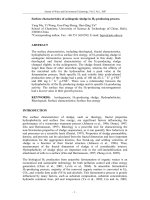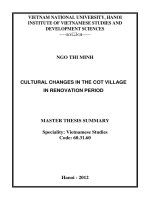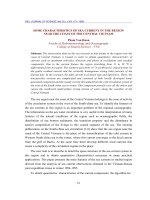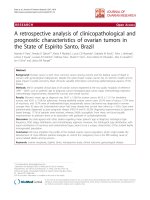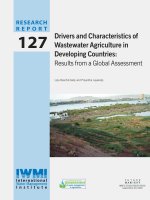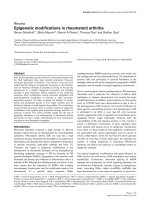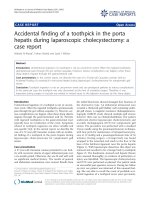Characteristics of epigenetic modifications in porcine cloned embryos during preimplantation development = đặc trưng của những biến đổi di truyền biểu sinh trên phôi heo nhân bản trong quá trình tiền làm tổ
Bạn đang xem bản rút gọn của tài liệu. Xem và tải ngay bản đầy đủ của tài liệu tại đây (23.86 MB, 212 trang )
o
INTERNATIONAL UNIVERSITY
Vietnam National University - Ho Chi Minh City
Characteristics of Epigenetic Modifications in
Porcine Cloned Embryos During
Preimplantation Development
Ph.D. Dissertation
Submitted by
NGUYEN THI THUY VAN
2021
Supervisor: Assoc. Prof. Bui Hong Thuy
Assoc. Prof. Nguyen Van Thuan
School of Biotechnology
Characteristics of Epigenetic Modifications in
Porcine Cloned Embryos During
Preimplantation Development
A dissertation submitted to The School of Biotechnology in partial fulfillment
of the requirements for the degree of Doctor of Philosophy in Biotechnology at
International University,
Vietnam National University - Ho Chi Minh City
Submitted by
NGUYEN THI THUY VAN
This certifies that the Dissertation of
Nguyen Thi Thuy Van is approved by
Independent Reviewers:
Prof. Teruhiko Wakayama
Dr. Tran Cam Tu
Examination Committee:
Chairman
Assoc. Prof. Nguyen Hoang Khue Tu
Reviewer
Prof. Hoang Nghia Son
Reviewer
Assoc. Prof. Nguyen Thanh Binh
Reviewer
Assoc. Prof. Tran Hoang Dung
Member
Assoc. Prof. Truong Hai Nhung
Member
Dr. Tran Thi Hai Yen
Member
Dr. Le Minh Thong
2021
School of Biotechnology
International University
Vietnam National University - Ho Chi Minh City
Declaration by author
This dissertation is my original work and it contains no material previously published or presented
by another person except stated in due reference. I have clearly specified the contribution by those
who co-authored published works that I have incorporated into this dissertation.
I have acknowledged the contribution of others to my dissertation, including experimental design,
statistical assistance, technical procedures, editorial advice, and financial support. I have officially
declared the content of my dissertation is the result of my own work since the commencement of
my research candidature. The dissertation contains no part of work that has been previously
submitted for the award of any other degree or certificate in any university or institution.
I acknowledge that an electronic copy of my dissertation must remain with the University’s Library
so that it will be made available for future research and study lawfully. Also, I declared herein that
I have obtained copyright permission from the copyright holder(s) to use the material in this
dissertation and have sought permission from co-authors for any jointly published work.
Author Signature and Date
Print Name and Title
i
Publications closely related to this dissertation
International articles
No
1
ISSN
Impact
(SCI/SCI-e)
factor
Thuy-Van NT1, My LBA1, Van-Thuan N and Hong-Thuy B (2020)
0093-691X
2.35
Improve the developmental competence of porcine oocytes from
(SCI/ Q1)
(2020)
Authors, title, journal name, journal index, page, year published
small
antral
follicles
by
pre-maturation
culture
method.
Theriogenology 149: 139-148.
Domestic articles
No
Authors, title, journal name, journal index, page, year published
ISSN
Thuy-Van NT1,2*, Duy PT1,2*, Van-Thuan N1,2 and Hong-Thuy B1,2
1811-4989
Impact
factor
(2019) Caffeine improves the developmental competence of
2
parthenogenetic embryos derived from aging porcine oocytes.
Journal of Biotechnology 17(4): 629-636.
Publications related to this dissertation
3
Ngan HTK1,*,Thuy-Van NT1,*, Van-Thuan N1 and Hong-Thuy B1
1348-4400
1.65
(2019) Epigenetic impairments in development of parthenogenetic
(SCIE/ Q1)
(2020)
preimplantation mouse embryos. Journal of Reproduction and
Development 65(1): 83-90.
ii
International conference and proceedings
No
Authors, title, conference name, page of proceeding, time and
location organized
Thuy-Van NT, Duy PT, An BT, Van-Thuan N and Hong-Thuy B
ISSN
ISSN
(2017) Effect of dibutyryl-cAMP (db-cAMP) and Follicle 1680-0737
1
2
Stimulation Hormone (FSH) on meiotic competence of porcine
oocytes during in vitro maturation and fertilization. Springer at
ISBN 978-
International Conference on the Developmental of Biomedical
981-10-
Engineering in Vietnam: 889-893.
4361-1
Thuy-Van NT1,2, Nghia DD1, Van-Thuan N1 and Hong-Thuy B1
ISSN
(2017) Effect of caffeine supplementation during in vitro
2198-4093
maturation on development of parthenogenetic embryos derived
from aging oocytes. Biomedical Research and Therapy 4(S): S150.
iii
Impact
factor
Domestic conference and proceedings
No
1
Authors, title, conference name, page of proceeding, time and
location organized
ISSN
Thuy-Van NT, Quynh NT, Van-Thuan N and Hong-Thuy B (2019)
ISBN
Ảnh hưởng của chất ức chế enzym histon deacetylase (Scriptaid)
978-604-73-
trên phơi heo nhân bản trong suốt q trình phát triển trước làm tổ.
7266-9
Hội nghị Cơng Nghệ Sinh Học Tồn Quốc tại TP. Hồ Chí Minh
(01/11/2019).
2
Anh-My LB, Long NCH, Thuy-Van NT, Van-Thuan N, Hong-
ISBN
Thuy B (2019) Ảnh hưởng của Axit Ascorbic đến khả năng phát
978-604-73-
triển của phôi heo trinh sản lưỡng bội. Hội nghị Cơng Nghệ Sinh
7266-9
Học Tồn Quốc tại TP. Hồ Chí Minh (01/11/2019).
Anh-My LB, Han VB, Thuy-Van NT, Van-Thuan N and Hong3
Thuy B (2019) Ascorbic acid and embryo aggregation induce
embryonic development in porcine. 2nd Vietnam Biology
Conference at ICISE-Quy Nhon (21/12/2019).
Thuy-Van NT, Van-Thuan N and Hong-Thuy B (2017) Ảnh hưởng
của caffeine lên sự phát triển phôi trinh sản lưỡng bội từ tế bào trứng
4
lão hoá. The 1st National Conference in Animal Reproduction at
Hanoi (22/4/2017).
Duy PT1, Thuy-Van NT1, Van-Thuan N and Hong-Thuy B (2017)
5
Ảnh hưởng của Dibutyryl-cAMP và Follicle Stimulating Hormone
lên q trình ni chín tế bào trứng heo trong ống nghiệm. The 1st
National Conference in Animal Reproduction at Hanoi (22/4/2017).
iv
Impact
factor
Contributions by others to the dissertation
No contributions by others.
Statement of parts of the dissertation submitted to qualify for the award of another degree
None
Research Involving Human or Animal Subjects
The research relating to animal subjects was followed the rules and regulations of The
International University, Vietnam National University- Ho Chi Minh City.
v
Acknowledgements
Foremost, I would like to express my sincere gratitude to my advisor Assoc. Prof. Bui Hong
Thuy and my co-supervisor Assoc. Prof. Nguyen Van Thuan for their continuous support of my
PhD study, for their professional guidance, technical knowledge and endurable patience that I have
perceived from the very beginning of my thesis.
I would like to express my appreciation to the lecturers and staffs at International University
(VNU-HCMIU) for their continuous support and assistance throughout my study.
I would like to express my thankfulness to Prof. Hoang Nghia Son and researchers at my
former institute, Institute of Tropical Biology, for their support and encouragement.
I would like to extend my thanks to all my labmates at Cellular Reprogramming Lab at
International University (VNU-HCMC), both undergraduates and master students (especially Le
Ba Anh My) who have supported me along the experiments and all my friends in life that have
encouraged me.
Finally, I would like to express my appreciation to my family for the love, patience and
encouragement that they have been shown me during the study of my doctoral dissertation.
vi
Financial support
I would like to extend gratitude towards Vissan Joint Stock Company (Ho Chi Minh city)
and Ut Hao Slaughterhouse (Di An, Binh Duong) for their supply of porcine ovaries. This project
was supported by the Vietnam Ministry of Science and Technology under Grant No. ĐTĐL.CN49/16; by Vietnam National University (Ho Chi Minh City) under Grant No. B2016-28-01 and
Grant No. B2017-28-04; by NAFOSTED under Grant No. 106-NN.99 2015/90.
Last but not least, I would like to express my appreciation to the International University
(Vietnam National University, Hochiminh City) for providing me the 50% scholarship to support
my PhD study.
vii
TABLE OF CONTENTS
Abstract
1
Tóm tắt
4
Chapter 1
GENERAL INTRODUCTION
7
1.1. Overview of somatic cell nuclear transfer (SCNT) technology
1.2. Effects of in vitro culture conditions on the quality of recipient oocytes
8
10
1.3. Effects of reprogramming factors of donor cells on the development of cloned
embryos
15
Chapter 2
EFFECTS OF MODULATING AGENTS ON THE MEIOTIC
COMPETENCE ACQUISITION AND PREIMPLANTATION
DEVELOPMENT OF PORCINE PARTHENOGENETIC DIPLOID
EMBRYOS
20
2.1. Introduction
21
2.2. Materials and Methods
24
2.2.1. Oocyte collection
24
2.2.2. Pre-in vitro maturation
27
2.2.3. In vitro maturation
27
2.2.4. Orcein staining for the assessment of meiotic competence
28
2.2.5. Electro-activation
28
2.2.6. In vitro culture
28
2.2.7. DAPI staining for the assessment of the embryo quality
29
2.2.8. Immunofluorescence Staining
29
viii
2.2.9. Statistical analysis
30
2.2.10. Experimental design
30
2.2.10.1. Effects of dbcAMP and FSH on meiotic competence of porcine oocytes and
the establishment of the electro-activation system
30
2.2.10.2. Effects of caffeine on the preimplantation development of parthenogenetic
diploid embryos derived from aging porcine oocytes
31
2.2.10.3. Effects of L-ascorbic acid on the preimplantation development and histone
modifications of porcine parthenogenetic diploid embryos during preimplantation
development
31
2.2.10.4. Effects of FBS supplementation on the preimplantation development of
porcine parthenogenetic diploid embryos
2.3. Results
34
34
2.3.1. Effects of dbcAMP and FSH on meiotic competence of porcine oocytes and
the establishment of the electro-activation system
34
2.3.1.1. Effects of dbcAMP and FSH on cumulus expansion of porcine oocytes
34
2.3.1.2. Effects of dbcAMP and FSH on the meiotic competence of porcine oocytes
37
2.3.1.3. Establishment of the electro-activation system
37
2.3.1.4. Effects of dbcAMP and FSH on the preimplantation development of porcine
parthenogenetic diploid embryos
37
2.3.1.5. Effects of dbcAMP and FSH on the quality of porcine parthenogenetic diploid
embryos
41
2.3.2. Effects of caffeine on the preimplantation development of parthenogenetic
diploid embryos derived from aging porcine oocytes
42
2.3.2.1. Effects of caffeine treatment after IVM on the preimplantation development of
porcine parthenogenetic diploid embryos derived from aging oocytes
42
2.3.2.2. Effects of caffeine treatment during MI – MII on the preimplantation
development of parthenogenetic diploid embryos derived from aging oocytes
ix
47
2.3.3. Effects of L-ascorbic acid on the preimplantation development and histone
modifications of porcine parthenogenetic diploid embryos during preimplantation
development
47
2.3.3.1. Effects of L-ascorbic acid on the meiotic competence of porcine oocytes
derived from small and large antral follicles
47
2.3.3.2. Effects of L-ascorbic acid on the preimplantation development of porcine
parthenogenetic diploid embryos developed from oocytes derived from small and large
antral follicles
50
2.3.3.3. Effects of L-ascorbic acid on the quality of porcine parthenogenetic blastocysts
developed from oocytes derived from small and large antral follicles
50
2.3.3.4. Effects of L-ascorbic acid on the expression of acetylation of H3K9 and
methylation of H3-K4 of porcine parthenogenetic diploid embryos developed from
oocytes derived from small and large antral follicles
53
2.3.4. Effects of FBS supplementation on the preimplantation development of
porcine parthenogenetic diploid embryos
56
2.3.4.1. Effects of different concentrations of FBS supplementation on the
preimplantation development of porcine parthenogenetic diploid embryos
56
2.3.4.2. Effects of different timings of FBS supplementation on the preimplantation
development of porcine parthenogenetic diploid embryos
58
2.4. Discussion
61
2.5. Conclusion
67
Chapter 3
EFFECTS OF HISTONE DEACETYLASE INHIBITOR (SCRIPTAID) ON
THE PREIMPLANTATION DEVELOPMENT AND EPIGENETIC
MODIFICATIONS OF PORCINE CLONED EMBRYOS
69
3.1. Introduction
70
3.2. Materials and Methods
73
x
3.2.1. Oocyte collection
73
3.2.2. In vitro maturation
73
3.2.3. Preparation of donor cells
73
3.2.4. Making of manipulation pipettes
75
3.2.5. Somatic cell nuclear transfer
75
3.2.6. Electro-activation
78
3.2.7. In vitro culture
78
3.2.8. Immunofluorescence Staining
78
3.2.9. Statistical analysis
78
3.2.10. Experimental design
79
3.3. Results
81
3.3.1. Effects of HDACi (Scriptaid) concentrations on the preimplantation
development of porcine cloned embryos
81
3.3.2. Effects of HDACi (Scriptaid) timings on the preimplantation development of
porcine cloned embryos
82
3.3.3. Effects of two-step HDACi (Scriptaid) treatment on the preimplantation
development and quality of porcine cloned embryos
85
3.3.4. Effects of two-step HDACi (Scriptaid) treatment on histone modifications of
porcine cloned embryos
88
3.3.5. Effects of two-step HDACi (Scriptaid) on the expression of OCT4 in porcine
cloned embryos
93
3.4. Discussion
94
3.5. Conclusion
98
Chapter 4
GENERAL SUMMARY
99
xi
SUPPLEMENTARY DATA
104
S.1. Effects of oocyte collection methods on the meiotic competence of porcine oocytes
104
S.2. Effects of in vitro culture media on the preimplantation development of porcine
parthenogenetic diploid embryos
104
S.3. Effects of the injection pipette's angle on the survival rate of porcine cloned
embryos after SCNT
106
S.4. Effects of the holding pipette's inner diameter on the manipulation time for
catching oocytes during SCNT
106
S.5. Effects of the manipulation chamber temperature on the survival rate of porcine
cloned embryos after SCNT
109
S.6. Effects of the size of the donor cell on the preimplantation development of porcine
cloned embryos
109
S.7. Effects of different timings of FBS supplementation on the preimplantation
development of porcine cloned embryos
110
REFERENCES
113
APPENDICES
131
xii
LIST OF FIGURES
Figure 1.1. The cloning procedure in the pig
9
Figure 1.2. The main objectives of the study
19
Figure 2.1. Schematic diagram of effects of caffeine on aging oocytes involving in decreasing
MPF activity
23
Figure 2.2. Different types of porcine ovaries from prepubertal gilts
25
Figure 2.3. Porcine oocytes collected by dissection method for IVM
26
Figure 2.4. Schematic depiction of L-ascorbic acid treatment
33
Figure 2.5. Classifications of cumulus cell expansion rate of porcine oocytes
35
Figure 2.6. Different nuclear stages of porcine oocytes after IVM
36
Figure 2.7. The production of two pronucleus after successful activation
38
Figure 2.8. Effects of dbcAMP and FSH on the quality of porcine parthenogenetic diploid
embryos
40
Figure 2.9. The morphology of porcine aging oocytes
44
Figure 2.10. Embryonic preimplantation developmental stages of parthenogenetic diploid
embryos derived from aging oocytes treated with caffeine
45
Figure 2.11. Effects of L-ascorbic acid on the meiotic competence of porcine oocytes derived
from small and large antral follicles
48
Figure 2.12. Effects of L-ascorbic acid on the preimplantation development of porcine
parthenogenetic diploid embryos developed from oocytes derived from small and large antral
follicles
51
Figure 2.13. Effects of L-ascorbic acid on the quality of porcine parthenogenetic blastocysts
developed from oocytes derived from small and large antral follicles
52
Figure 2.14. Effects of L-ascorbic acid on the expression of acetylation at H3K9 (H3K9-Ac)
in porcine parthenogenetic diploid embryos developed from oocytes derived from small
and large antral follicles
54
Figure 2.15. Effects of L-ascorbic acid on the expression of dimethylation at H3K4
(H3K4-Me2) in porcine parthenogenetic diploid embryos developed from oocytes derived
from small and large antral follicles
55
Figure 2.16. Effects of different concentrations of FBS supplementation on the preimplantation
development of porcine parthenogenetic diploid embryos
xiii
57
Figure 2.17. Effects of different timings of FBS supplementation on the quality of porcine
parthenogenetic diploid embryos
59
Figure 3.1. The culture scheme of lung cell fibroblast
74
Figure 3.2. The making of manipulator pipettes
76
Figure 3.3. The process of SCNT
77
Figure 3.4. Schematic depiction of HDACi treatment
80
Figure 3.5. Effects of Scriptaid treatment on the preimplantation development of porcine
cloned embryos
84
Figure 3.6. Effects of two-step Scriptaid treatment on the preimplantation development
of porcine cloned embryos
87
Figure 3.7. Effects of two-step Scriptaid treatment on acetylation levels of H3K9 (H3K9-Ac)
89
in porcine cloned embryos
Figure 3.8. Effects of two-step Scriptaid treatment on methylation levels of H3K9 (H3K9-Me)
in porcine cloned embryos
90
Figure 3.9. Effects of two-step Scriptaid treatment on OCT4 expressions in porcine cloned
embryos
91
Figure 3.10. Porcine cloned embryos produced under the optimized culture system and two-step
Scriptaid treatment
92
Figure S.1. Effects of in vitro culture media on the preimplantation development of porcine
parthenogenetic diploid embryos
105
Figure S.2. Effects of the injection pipette angle on the survival rate of porcine cloned
embryos after SCNT
107
Figure S.3. Effects of the holding pipette's inner diameter on the manipulation time for
catching oocytes during SCNT
108
Figure S.4. Effects of the size of the donor cell on the preimplantation development of porcine
cloned embryos
111
Figure S.5. Effects of different timings of FBS supplementation on the preimplantation
development of porcine cloned embryos
112
xiv
LIST OF TABLES
Table 2.1. Effects of dbcAMP and FSH on the cumulus expansion rate of porcine oocytes
35
Table 2.2. Effects of dbcAMP and FSH on the meiotic competence of porcine oocytes
after IVM
36
Table 2.3. Effects of different electrical settings on pronuclear formation after activation
38
Table 2.4. Effects of dbcAMP and FSH on the preimplantation development of porcine
parthenogenetic diploid embryos
39
Table 2.5 Effects of dbcAMP and FSH on the quality of porcine parthenogenetic diploid
embryos
40
Table 2.6. Effects of caffeine treatment after IVM on the preimplantation development
of porcine parthenogenetic diploid embryos
43
Table 2.7. Effects of caffeine treatment during MI – MII on the preimplantation development
of parthenogenetic diploid embryos derived from aging oocytes
46
Table 2.8. Effects of different timings of FBS supplementation on the preimplantation
development of porcine parthenogenetic diploid embryos
60
Table 3.1. Effects of two-step HDACi (Scriptaid) treatment on the preimplantation
development of porcine cloned embryos
86
Table S.1. Effects of oocyte collection methods on the meiotic competence of porcine oocytes 104
Table S.2. Effects of the manipulation chamber temperature on the survival rate of porcine
109
cloned embryos after SCNT
xv
APPENDICES
Appendix 1. Effects of L-ascorbic acid on the meiotic competence of porcine oocytes derived from
small and large antral follicles
131
Appendix 2. Effects of L-ascorbic acid on the development competence of parthenogenetic diploid
embryos
132
Appendix 3. Effects of L-ascorbic acid on the quality of porcine parthenogenetic diploid embryos
133
Appendix 4. Effects of L-ascorbic acid on the expression of acetylation at H3K9 (H3K9-Ac) in
porcine parthenogenetic diploid embryos
134
Appendix 5. Effects of L-ascorbic acid on the expression of dimethylation at H3K4 (H3K4-Me2)
in porcine parthenogenetic diploid embryos
134
Appendix 6. Effects of different concentrations of FBS supplementation on the preimplantation
development of porcine parthenogenetic diploid embryos
135
Appendix 7. Effects of the size of the donor cell on the preimplantation development of porcine
cloned embryos
136
Appendix 8. Effects of HDACi (Scriptaid) concentrations on the preimplantation development of
porcine cloned embryos
137
Appendix 9. Effects of HDACi (Scriptaid) timings on the preimplantation development of
porcine cloned embryos
138
Appendix 10. Effects of two-step HDACi (Scriptaid) on the expression of acetylation at H3K9
(H3K9-Ac) in porcine cloned embryos
139
Appendix 11. Effects of two-step HDACi (Scriptaid) on the expression of methylation at H3K9
(H3K9-Me) in porcine cloned embryos
139
Appendix 12. Effects of two-step HDACi (Scriptaid) on the expression of OCT4 in porcine
cloned embryos
139
Appendix 13. Effects of in vitro culture medium on the development of porcine parthenogenetic
diploid embryos
140
Appendix 14. Effects of the injection pipette's angle on the survival rate of porcine cloned embryos
after SCNT
141
Appendix 15. Effects of the holding pipette's inner diameter on the manipulation time for
catching oocytes during SCNT
141
xvi
Appendix 16. Effects of different timings of FBS supplementation on the preimplantation
development of porcine cloned embryos
142
xvii
ABBREVIATIONS
AI : Anaphase I
ART : Assisted Reproductive Technology
BSA : Bovine serum albumin
cAMP : cyclic adenosine monophosphate
CB : Cytochalasin B
Cdk : Cyclin-dependent kinase
COCs: Cumulus-oocyte-complexes
DAPI : 4,6-diamidino-2-phenylindole
dbcAMP : dibutyryl cyclic adenosine monophosphate
DMEM : Dulbecco's Modified Eagle Medium
EAA : Essential amino acid
EDTA : Ethylene diamine tetracetic acid
FBS : Fetal bovine serum
FSH : Follicle stimulating hormone
GV : Germinal vesicle
GVBD : Germinal vesicle breakdown
hCG : Human chorionic gonadotropin
HDAC : Histone deacetylase
HDACi : Histone deacetylase inhibitors
HEPES : 4-(2-Hydroxyethyl)piperazine-1ethanesulfonic acid
hpa : hour post activation
IVC : In vitro culture
IVM : In vitro maturation
LH : Luteinizing hormone
MI : Metaphase I
MII : Metaphase II
MPF : Maturation promoting factor
M-phase : Metaphase
NEAA : Nonessential amino acid
NCSU23 : North Carolina State University 23
xviii
OCGs : Oocytes-cumulus-granulosa cell complexes
PCOS : Polycystic ovary syndrome
pre-IVM : Pre-in vitro maturation
PVA : Polyvinyl alcohol
ROS : Reactive Oxygen Species
SCNT : Somatic cell nuclear transfer
SCR : Scriptaid
TCM-199 : Tissue Culture Medium 199
TI : Telophase I
TSA : Trichostatin A
WM : Whitten’s Medium
ZGA : Zygotic gene activation
xix
Abstract
Characteristics of Epigenetic Modifications in Porcine
Cloned Embryos During Preimplantation Development
Nguyen Thi Thuy Van
School of Biotechnology
International University, VNU-HCM
Somatic cell nuclear transfer (SCNT) in mammals is an assisted reproductive technique
used to produce an animal from a single cell nucleus using an enucleated oocyte as a recipient.
This technique holds great potential to be applied in various biotechnological aspects including
pharmaceutical technologies, stem cell therapy, biomedical applications, increasing productivity
in animal production, preserving endangered species and applying research on gametes and
embryos. However, the success rate of clones was still very low due to the quality of the recipient
oocytes and the reprogramming of the donor cell nucleus.
In Chapter 1, we introduced about our two main objectives in this study. Our first main
objective is to improve the quality of the recipient oocytes. To achieve this target, we established
an optimal system for in vitro maturation (IVM), activation procedure and in vitro culture (IVC)
of porcine oocytes using parthenogenetic model and subsequently apply the system to generate the
recipient oocytes for SCNT and to culture cloned embryos. Next, our second objective is to
reprogram the donor nucleus using HDACi (Scriptaid). Our final examination was on the
characteristics of epigenetic modifications of cloned embryos during preimplantation
development.
In Chapter 2, we investigated effects of modulating agents during in vitro maturation on
the quality of porcine mature oocytes and parthenogenetic diploid embryos. Our results showed
that the combination of 1 mM dbcAMP and 0.01 IU/ml FSH supplemented to the maturation
medium could increase the quality of mature oocytes and improve the preimplantation
1
development of parthenogenetic diploid embryos, which produced a higher rate of the embryos
developed to the blastocyst stage and higher number of good quality blastocysts.
Moreover, oocytes are committed to deterioration in quality as they aged due to a long
duration manipulation which leads to the reduced success rate of SCNT. We found that 5 mM
caffeine during Metaphase I- Metaphase II (MI-MII) transition could efficiently improve the
preimplantation development of embryos derived from aging oocytes (48 h, 36.95% blastocysts)
as well as those derived from fresh oocytes (42 h, 38.73% blastocysts, p>0.05).
On the other hand, due to the limited number of fully-grown oocytes on the ovary, the
research on the in vitro maturation and development of immature oocytes could be important in
order to supply a large quantity of mature oocytes to produce embryos for subsequent
experiments. Therefore, we investigated effects of L-ascorbic acid supplementation during IVM
on porcine parthenogenetic diploid oocytes derived from both small antral (2-3 mm) and large
antral (4-6 mm) follicles with L-ascorbic acid supplement during pre-maturation and maturation,
respectively. Moreover, according to the author’s knowledge, no comprehensive work was
dedicated to introduce hCG at the end of pre-IVM to shorten the culture time. Together with the
new culture system, our study suggested that L-ascorbic acid supplementation at 100 μg/ml
sharply enhanced the developmental potential of porcine oocytes to the blastocyst stage and the
quality of blastocysts in both oocytes collected from small and large antral follicles. Moreover,
the L-ascorbic acid-treated embryos showed a significantly higher number of blastomeres and
increased levels of acetylation of H3K9 and dimethylation of H3K4 in blastocyst derived from
both small and large antral follicle.
Our results also showed that FBS supplementation at 5% during the embryo development
significantly increased the number of parthenogenetic diploid embryos reaching late-to-hatched
blastocysts. Especially, FBS supplementation at Day 4 significantly improved the quality of both
parthenogenetic diploid and cloned blastocysts compared to the control.
In Chapter 3, the effects of Scriptaid on preimplantation development of cloned porcine
embryos and the epigenetic modifications were examined. In this study, first, porcine cloned
2
embryos were treated with Scriptaid for 6 hours at different concentrations (0, 100, 200, 400 and
800 nM) after activation. Second, we examined the effect of Scriptaid treatment at 42-48h and at
48-54 h post-activation (hpa) on preimplantation development. Last, we investigate the effects of
two-step Scriptaid treatment in which the first step from the time of activation and the second step
from 42 h (pact) on the preimplantation development of porcine cloned embryos. The results of
the first experiment showed that Scriptaid at 200 nM reached the highest number of cloned
blastocysts. The results of the second experiment showed that, cloned embryos treated with
Scriptaid after activation showed the highest number of embryos that developed to the blastocyst
stage (0 hpa, 17.84%). Interestingly, Scriptaid treatment at the early 4-cell stage embryo (42 hpa)
has a comparable percentage of blastocyst compared to the 0 hpa group (p<0.05) and has the
blastocyst rate (14.18%) higher compared to those treated at late 4-cell stage (48 hpa, 7.15%). In
the last experiment, the two-step Scriptaid treatment showed the significantly highest rate of
blastocyst (35.02%) and the highest rate of late/hatched blastocyst (18.65%) among the four
treatments (p<0.05). In addition, it had significantly increased in the total cell number of porcine
cloned blastocysts (68.20, p<0.05). Nevertheless, two-step Scriptaid treatment had increased the
level of histone acetylation of H3K9 and significantly decreased the level of H3K9-Me compared
to the control group, suggesting an open space for gene expression in porcine cloned embryos.
Moreover, a decrease in H3K9-Me could help to enhance the level of gene expression. Our results
indicated that the two-step Scriptaid treatment had improved the correction of aberrant gene
expressions, showing the highest level of OCT4 expression (68.18, p<0.05) among all treatments.
In Chapter 4, the main results of this study were summarized. Based on parthenogenetic
diploid embryos as an efficient model, we had established the culture system to provide high
quality recipient oocytes and the optimal culture system to develop cloned embryos. Importantly,
the two-step Scriptaid treatment had rescued the aberrant modifications of histone in cloned
embryos during preimplantation development.
Keywords: FSH, dbc AMP, caffeine, L-ascorbic acid, FBS, dissection, Scriptaid, H3K9-Ac, H3K9-Me, H3K4Me2, OCT4, SCNT, porcine parthenogenetic diploid embryos, porcine cloned embryos
3
